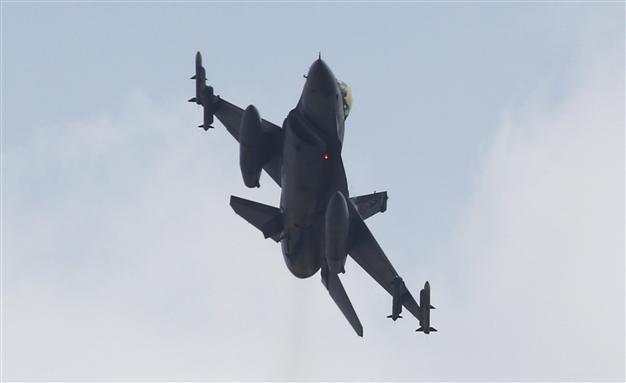Tension high on Turkey-Syria border since 2012
ISTANBUL

A Turkish F-16 fighter jet takes off from Incirlik airbase in the southern city of Adana, Turkey, in this July 27, 2015 file picture. REUTERS Photo
Turkey downed a Russian-made fighter jet due to an airspace violation on the morning of Nov. 24, but tension on Turkey’s border with Syria has been high since 2012, when Syria downed a Turkish jet leading to the death of two pilots.Tension on the border started when an unarmed Turkish military plane conducting a test mission was shot down by Syria on June 22, 2012. Turkey claimed that the plane was shot down in international airspace with a laser- or heat-guided missile; Syria, however, said they shot the plane down with anti-aircraft guns as the plane flew within Syrian airspace at an altitude of 100 meters.
According to radar traces provided by the chief of Turkish General Staff, the Turkish F-4 jet was downed 13 nautical miles off the Syrian coast in international waters but crashed in Syrian territorial waters. The graphics showed the Turkish jet had unintentionally violated Syrian airspace at 11:42 a.m. for five minutes, only 16 minutes before contact was lost with the jet. At 11:44 a.m. Turkish radars informed the jet that it had entered Syrian airspace and told it to leave as soon as possible.
Syrian foreign ministry spokesman Jihad Makdissi said the shooting of the plane was an accident.
“What happened was an accident and not an assault as some like to say, because the plane was shot while it was in Syrian airspace and flew over Syrian territorial waters,” Makdissi said June 24, 2012.
Turkey adopted strict rules of engagement in 2012 after the F-4 incident, announcing that it would consider any naval, air or land vehicles approaching Turkish territory from Syria as a threat.
The air dispute also effected the situation on land on the Turkish-Syria border starting October 2012, when Syrian regime forces initially fired shells at a village close to the border in Turkey’s Hatay province, killing five Turkish civilians. Syrian shells continued to hit border villages throughout October 2012.
On Oct. 4, 2012, the Turkish parliament passed a motion allowing the military to conduct cross-border raids into Syria.
Around one-and-a-half years later, Turkey said its fighter jets shot down a Syrian jet on March 23, 2014, after it had crossed into Turkish airspace and warned the Syrian regime of a “heavy response” if its airspace was violated again.
The Turkish Armed Forces (TSK) said Turkish radars detected two Syrian MIG-23s approaching Turkish airspace at 1:00 p.m. local time on March 23, 2014, and warned the pilots to their approach towards the Turkish border four times. One of the jets changed its route and returned to Syria, but the other flew into Turkish airspace for nearly 1.5 kilometers, the TSK said. The pilot was able to eject before the jet was downed in Syrian territory.
On May 16, Turkey announced that a Turkish F-16 jet shot down a Syrian helicopter violating its airspace, while Syrian state TV reported that it was a surveillance drone that was downed.
On Oct. 3, Turkish military sources said a Russian SU-30 breached Turkish airspace for hundreds of meters in the southern district of Yayladağı in the Hatay province for two minutes at 12:10 p.m., but returned to Syrian airspace after one warning.
After the airspace violation, Turkish Prime Minister Ahmet Davutoğlu said Turkey had warned Russia in order to prevent repeat violations, stressing that Russian authorities had assured Turkey that the Oct. 3 violation was unintentional and future mistakes would not be made.
On Oct. 16, Turkish jets shot down an “unmanned aerial vehicle” inside Turkish airspace near the Syrian border, the Turkish military said in a written statement, which fell on Turkish soil.
Turkish General Staff said the vehicle had been warned three times before a Turkish aircraft on a patrol mission on the border fired and shot down the vehicle within the rules of engagement.
A U.S. official told Reuters that Washington believed the drone was of Russian origin. The Russian Defense Ministry, however, said all of its planes in Syria had safely returned to base and all its drones were operating “as planned.”
On Nov. 11, Pentagon Press Secretary Peter Cook said the first six 12 U.S. Air Force F-15 jet fighters had arrived at Adana’s İncirlik Air Base to conduct combat air patrols and secure the sovereignty of Turkish airspace, at the request of its government.
On Nov. 19, Turkish Foreign Ministry summoned the Russian ambassador to Turkey over a bombing attack targeting Turkmen villages in northwestern Syria.
Following a Syria-themed security meeting on Nov. 22, Davutoğlu said Turkey was following the situation in Bayırbucak, the region where Syria’s Turkmens live, closely and underlined Turkey’s border safety as a number one priority.
“If there is a development that threatens Turkey regarding border security, we have given our security forces the instruction to respond immediately,” Davutoğlu said on Nov. 22.
















